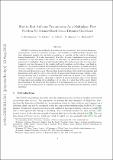Host-to-host airborne transmission as a multiphase flow problem for science-based social distance guidelines
Author(s)
Balachandar, S; Zaleski, S; Soldati, A; Ahmadi, G; Bourouiba, L
DownloadSubmitted version (3.161Mb)
Publisher with Creative Commons License
Publisher with Creative Commons License
Creative Commons Attribution
Terms of use
Metadata
Show full item recordAbstract
© 2020 Elsevier Ltd The COVID-19 pandemic has strikingly demonstrated how important it is to develop fundamental knowledge related to the generation, transport and inhalation of pathogen-laden droplets and their subsequent possible fate as airborne particles, or aerosols, in the context of human to human transmission. It is also increasingly clear that airborne transmission is an important contributor to rapid spreading of the disease. In this paper, we discuss the processes of droplet generation by exhalation, their potential transformation into airborne particles by evaporation, transport over long distances by the exhaled puff and by ambient air turbulence, and their final inhalation by the receiving host as interconnected multiphase flow processes. A simple model for the time evolution of droplet/aerosol concentration is presented based on a theoretical analysis of the relevant physical processes. The modeling framework along with detailed experiments and simulations can be used to study a wide variety of scenarios involving breathing, talking, coughing and sneezing and in a number of environmental conditions, as humid or dry atmosphere, confined or open environment. Although a number of questions remain open on the physics of evaporation and coupling with persistence of the virus, it is clear that with a more reliable understanding of the underlying flow physics of virus transmission one can set the foundation for an improved methodology in designing case-specific social distancing and infection control guidelines.
Date issued
2020-09Department
Massachusetts Institute of Technology. Department of Civil and Environmental EngineeringJournal
International Journal of Multiphase Flow
Publisher
Elsevier BV
Citation
S. Balachandar, S. Zaleski, A. Soldati, G. Ahmadi, L. Bourouiba, Host-to-host airborne transmission as a multiphase flow problem for science-based social distance guidelines, International Journal of Multiphase Flow, Volume 132, 2020, 103439
Version: Original manuscript
ISSN
0301-9322